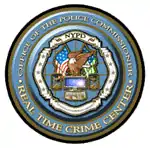Real Time Crime Center
The Real Time Crime Center (RTCC) is a centralized technology utilized by law enforcement and emergency first responders. During early adoption, the primary purpose of RTCC was to give field officers and detectives instant information to help identify patterns and stop emerging crime. With emerging cloud-based technology, Real Time Crime Centers in the Cloud have evolved to afford enhanced visibility, unified awareness, and the appropriate level of response in emergency resource deployment. Technological advances in RTCC seeks to continually improve emergency response times in the form of instant-live video, live feed camera docking, virtual incident location mapping and full integration with computer-aided-dispatch (CAD).

Police departments that have Real Time Crime Centers, include the New York Police Department, Miami-Dade Police Department, Seattle Police Department, Fort Worth Police Department, Metropolitan Police Department, City of St. Louis, Albuquerque Police Department, Austin Police Department,[1] Tampa Police Department, Fresno Police Department, Minneapolis Police Department and Houston Police Department.[2]
Early Adoption
The NYPD RTCC opened on July 18, 2005 and provides support 24/7. The center was built at a cost of $11 million. The information in the center is available to the 37,000 police officers of the New York City Police Department. The RTCC was funded in part by grants from the non-profit New York City Police Foundation.[3]
RTCC data sources include a data warehouse in which billions of records are made available to detectives and other officers within minutes, instead of days or weeks. These include:[4]
- More than 5 million New York State criminal records, parole and probation files,
- More than 20 million New York City criminal complaints, arrests, 911/311 calls and summonses spanning five years,
- More than 31 million national crime records,
- More than 33 billion public records.
The Crime Center employs satellite imaging and mapping of New York City (using Geographic Information System software) precinct-by-precinct. The link analysis capacity of the RTCC can track suspects to their known addresses and point detectives to the locations where they are most likely to flee. The Real Time Crime Center was built with the oversight of provider Dimension Data.
Emerging Cloud-Based Technology and Innovation
Real Time Crime Center (RTCC) in the Cloud are centralized technology platforms which extracts and unifies live video and data feeds from virtually any source, creating a central hub that enhances the situational awareness and investigative capabilities of law enforcement and public safety agencies.
On April 1, 2020, the Minneapolis Police Department's Strategic Information Center (SIC) announced a partnership with, Fūsus, to activate a ground-breaking law enforcement platform, fūsusONE, which will be live and fully operational on April 16, 2020.[5]
"We’ve worked closely with the Fusus team to help create a real-time crime center solution that truly meets the day-to-day intelligence needs of our department,” said Commander Scott Gerlicher of the MPD’s Special Operation and Intelligence Division.
“The activation of the Fusus platform represents a significant step forward not just for the MPD's crime mitigation and public safety efforts, but for law enforcement technology in general. With the Fusus platform in place, the MPD will be one of the first Police Departments in the nation to be leveraging a real-time crime center in the cloud solution.”
The Fūsus Unified Awareness Platform will bring the following capabilities to the MPD’s SIC
- Computer Aided Dispatch (CAD) Integration -along with video correlation to Priority 1 locations
- Integration to Minneapolis 911 dispatch
- Live video from the Minneapolis Downtown Improvement District area
- Community Camera Registry Location Data
- Live Cell Phone Video during an ongoing incident
- Live Video from Stadiums and other Community Owned Video Sources
- ShotSpotter Gunfire Detection Integration
- Mutual Aid with other law enforcement agencies
- Community shared video and photo for Tips via SMS-Text
- fūsusALERT Panic App integration for(policy-based) video sharing on alert
- fūsusOPS Officer Locations, Text Communications,and Team Coordination for Incident Management
- Floor plan Integrations to Locations of Interest
References
- Rangel, Leslie (2016-08-02). "How police monitors situations in downtown Austin in realtime". KXAN. Retrieved 2018-10-10.
- HPD's High-tech center helping solve crimes
- "MPD to activiate Fusus Real Time Crime Center Platform".